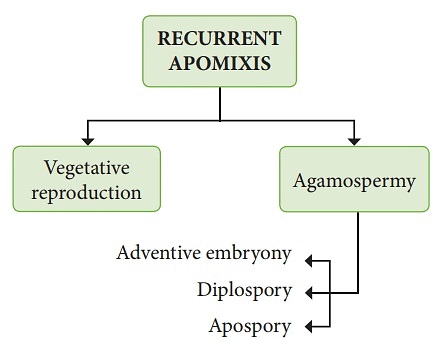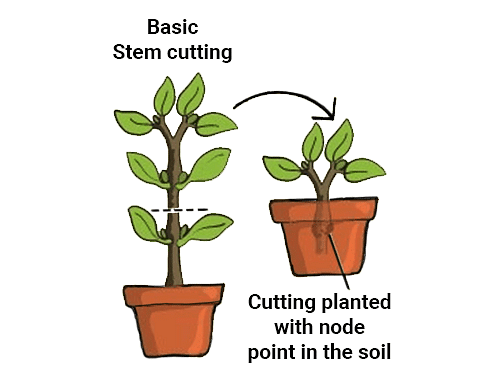Asexual Reproduction in Plants | Biology Class 12 - NEET PDF Download
Asexual Reproduction
- In asexual reproduction, the new individual is produced by any means other than the fusion of sex gametes.
- It means a "reproduction in which new individuals are formed without meiotic division and fusion of gametes is called asexual reproduction." In this way asexual reproduction is also known as apomixis. (Greek - Apo = without; mixis = mixing). Apomixis term was suggested by Winkler.
- The Apomixis is characterised by the quick multiplication and reproduction of genetically similar plants from the single parent. Such a population produced from a single individual is called a "clone" and each member of the clone is called ramet.
In flowering plants, there are two main types of Recurrent Apomixis:
- Agamospermy
- Vegetative Propagation

1. Agamospermy
- In this type of method, the embryo is formed without fertilization and meiotic division is called agamospermy.
- It means plants belonging in this category propagated through seeds but the embryo formation does not involve meiosis and syngamy.
There are three different types of Agamospermy:
(i) Diplospory
In this method, archesporium differentiates to form a megaspore mother cell but this megaspore mother cell directly gives rise to an embryo sac without meiosis. This embryo sac is diploid and a diploid embryo is formed without fertilization from the diploid egg of this embryo sac.
Example: Parthenium, Taraxacum.
(ii) Adventive Embryony
In this method, an embryo is formed from any diploid cells (Nucleus or integuments) of the ovule except the embryo sac. This diploid cell behaves like a zygote. Adventive embryony derived from Nucleus in Citrus, Mangifera, Opuntia, Mamillaria and from Integuments in Spiranthus australis.
(iii) Apospory
It is discovered by Rosenberg in the Heiarcium plant. In this method embryo sac or female gametophyte is directly formed from any diploid cell of the sporophyte except megaspore mother cell without meiosis is known as apospory. In this, gametophyte always remains diploid.
Example: Hieracium, Ranunculus and Rubus.
2. Vegetative Reproduction/ Propagation
- Plants belonging to this category propagate by a part of their body other than a seed. The structural unit that is employed in place of seed for the propagation of new plants is called propagule.
- In Angiosperms any parts of the plants - roots, stems and leaves used for vegetative propagation.
Generally, the method of vegetative propagation have been further divided into two types:
(i) Natural Vegetative Propagation
(a) By Roots: The modified tuberous root of Sweet potato (Ipomoea batatas), Asparagus, Tapioca, Yam, Dahlia and Tinospora can be propagated vegetatively when planted in soil. In some plants, adventitious buds develop on the ordinary roots like - Dalbergiasisso, Populus, Guava, Murraya, Albizzia lebbek etc. which grow to form new plants. The buds present on the roots grow into leafy shoot above the ground is called Slips.
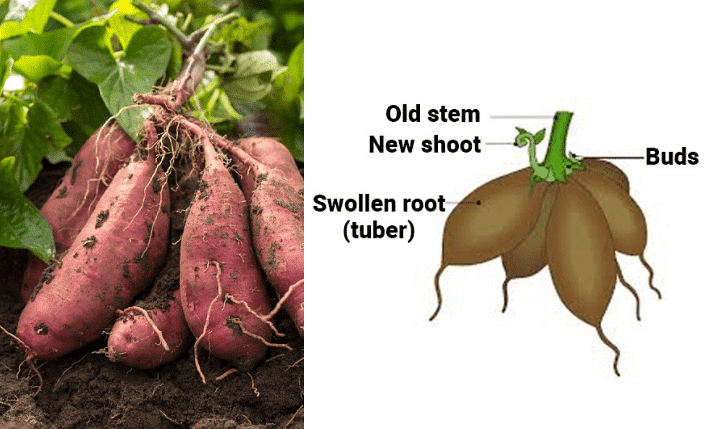 Natural Vegetative Propagation in Sweet Potato(b) Underground Stem: In some plants underground modified stem such as - Rhizomes - Typha; Canna, Ginger, Turmeric, Lotus, Musa etc. Corm - Gladiolus, Colocasia, Crocus, Amorphophallus, Alocasia etc. Bulbs - Onion, Garlic and Lilies Tubers - Potato, Helianthus tuberosus etc. which grow to form a new plant. Sucker - Mint and Chrysanthemum.
Natural Vegetative Propagation in Sweet Potato(b) Underground Stem: In some plants underground modified stem such as - Rhizomes - Typha; Canna, Ginger, Turmeric, Lotus, Musa etc. Corm - Gladiolus, Colocasia, Crocus, Amorphophallus, Alocasia etc. Bulbs - Onion, Garlic and Lilies Tubers - Potato, Helianthus tuberosus etc. which grow to form a new plant. Sucker - Mint and Chrysanthemum.
(c) Creepers: In the creeping stem of the plants' adventitious root is developed from the nodes and to form aerial shoots such as:
- Runners - Cynodon, Oxalis and Centella
- Stolon - Fragaria (Strawberry) & Vallisneria
- Offset - Pistia, Eichhornia (water hyacinth)
- Aerial stem - Opuntia
(d) Leaves: Some plants produce adventitious buds on their leaves.
Examples: Bryophyllum, Begonia, Streptocarpus, Saintpaulia.
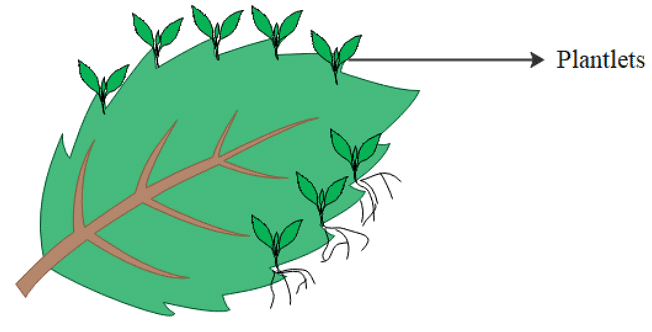 Vegetative Propagation on Leaf of BryophyllumThese buds remain dormant when the leaves attached with plants but after separation, when it comes in contact with moist soil develop new plantlets (buds) which form new plants.
Vegetative Propagation on Leaf of BryophyllumThese buds remain dormant when the leaves attached with plants but after separation, when it comes in contact with moist soil develop new plantlets (buds) which form new plants.
In the Kalanchoe plant, the whole portion of the leaf blade regenerates a new plant.
In some of the plants, fleshy axillary buds that develop from the axis of leaves are called Bulbils.
Examples: Dioscorea, Oxalis, Dentaria, Globba, Agave, Lilium.
There is a special type of fleshy buds that develop in the Aquatic plant, called Turions.
Examples: Potamogeton, Utricularia.
(ii) Artificial Propagation
Gardeners and Horticulturist have employed various method of vegetative propagation for economic production. All the methods are man-made so that their practices constitute artificial means of vegetative propagation.
These are as follows:
(i) Cutting: A cutting is a separated portion of root, stem or leaf which is used for propagation.
Factors are taken into consideration for successful propagation such as:
- Age of the parent plant
- Length and diameter of the cutting
- Season
- Type of plants
 Artificial Propagation by Cutting
Artificial Propagation by Cutting
Sometimes the stem cuttings are treated with a rooting hormone (IBA, IAA or NAA) for the proper development of adventitious roots.
Examples: Sugar cane, Rose, Croton, Tapioca, China rose (Stem cutting) Lemon, Tamarind (Root Cutting), Sansevieria (Leaf-cutting).
The favourable time for cutting is the Rainy season.
(ii) Grafting: It is the most common method of vegetative propagation described by ancient gardeners long before the science of horticulture became established. In this method, parts of two plants are joined in such a way that they grow as one plant.
Grafting is done between two closely related dicotyledonous plants having vascular cambium. The rooted supported portion of one plant called Stock is joined with a twig of another plant called Scion. Generally, the rootstock belongs to wild variety which is resistant to disease & pest.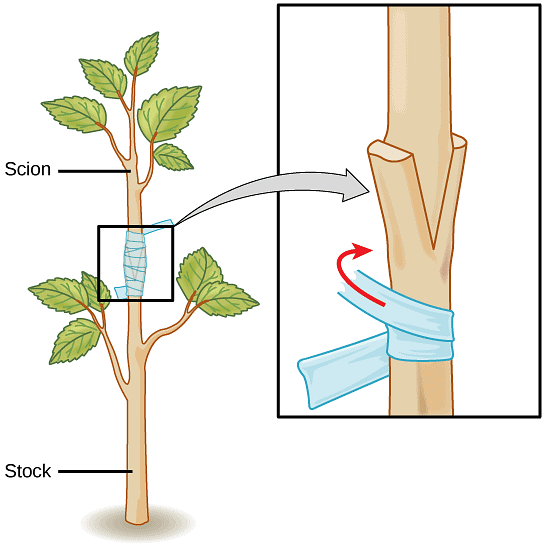 GraftingThe scion is derived from the plant possessing better characters. In grafting, the stock and scion cuts are marked in such an oblique manner so that they fix with each other. This joint covered with clay or a layer of wax. Within a few days, tissues of stock and scion combine together to form a new plant.
GraftingThe scion is derived from the plant possessing better characters. In grafting, the stock and scion cuts are marked in such an oblique manner so that they fix with each other. This joint covered with clay or a layer of wax. Within a few days, tissues of stock and scion combine together to form a new plant.
Example: Grafted Mango, Roses, orange, Seedless Grapes and Guava, Apple, Pear.
The favourable time for grafting is the Spring season.
Different types of Grafting are:
(a) Tongue Whip-grafting
(b) Wedge-grafting
(c) Crown grafting
(d) Side grafting
(e) Approaching grafting
Bud Grafting: This method is similar to grafting except that scion in this case consists of a bud along with some portion of bark having intact cambium.
Generally, bud grafting is done during the rainy season
Examples: Roses, Peach.
(iii) Layering: This method is used in those plants which are having flexible long branches. In this method, roots are artificially induced on the stem branches before they are detached from the parent plants for propagation.
There are two common types of layerings: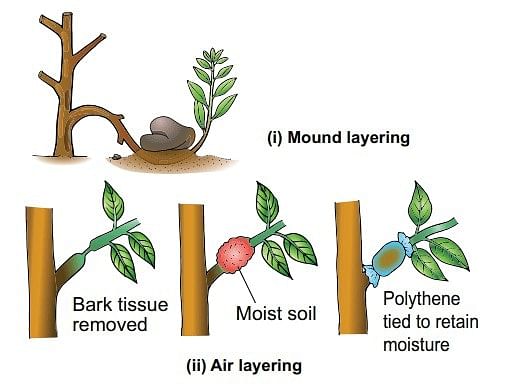 Types of Layering
Types of Layering
(a) Mound/Ground Layering: This method is only utilized in herbaceous plants. In this method, the lower branch of the stem is bent down and partially defoliated and injury is made on the defoliated part. It is covered by a thin layer of moist soil in such a way that the growing tip of the branch remains above the soil surface. After a few days, the pegged portion develops adventitious roots. Then rooted branch cut and separated from the parent and grown into a new plant.
Example: Jasmine, strawberry, Raspberry etc.
(b) Air Layering or Gootee: This method is commonly employed in the case of shrubs and trees which do not possess branches near the ground. In this method, a ring of bark is removed (girdled) from the aerial branch. This girdled portion is covered with moist grafting clay (2parts clay + 1 part cow dung + some pieces of hay + cotton + water) and wrapped with a polythene sheet. This wrapped portion of the branch is called Gootee. Inside the gootee, roots developed within a period of a or two month(s).
Examples: Litchi, Pomegranate, Orange, Lemon, Bougainvillea, Guava etc.
➢ Merits of Vegetative Propagation
- It is good for the multiplication of seedless plants.
Examples: Banana, Sugarcane, Pineapple and seedless Orange and Grape. - It is the fastest method of reproduction.
Examples: Potato crop requires more than one year with the help of seeds, however, it takes only 3 to 4 months with the help of tubers. Similarly, Lily takes 4 to 7 years through seeds, however, 1 to 2 years by bulbs. - By grafting, desirable quality of fruit/flower/seed can be obtained.
- Disease-free plants can be cultured by micro-propagation and micrografting.
- Plants with long seed dormancy or poor seed viability or poor seed can be propagated vegetatively.
Examples: Cynodon dactylon (Lawn, Doob or Bermuda grass). - Good quality and better yield varieties can be preserved for a long duration in the offsite collection, herbarium, botanical gardens etc.
- It gives 100% genetical similarity to their parents i.e., clone.
➢ Demerits of Vegetative Propagation
- Diseased parents always give diseased clone.
- Clone undergoes degeneration due to the absence of sexual reproduction.
- Vegetative organs cannot be preserved for long-duration like culms of Sugarcane.
- Vegetative propagatory organs or structures cannot be safely and easily stored in comparison to seeds. They are easily decomposed and attached by various pathogens like Bacteria, Virus, Fungi.
- Do not cause any variation in plantlets, thus decrease in the adaptation power.
- There is the absence of a dispersal mechanism. Vegetative propagation in a particular area causes overcrowding. It results in intraspecific competition.
➢ Significance Of Vegetative Propagation
- It is the only method of reproduction in those plants which have lost their capacity to produce seeds.
Examples: Banana, Seedless grapes, Orange etc. - The plants which produce small quantities of seeds, poor viability of seed or prolonged seed dormancy, reproduce only by this method because it is more rapid, easier and less expensive.
- Production of these plants is more as compared to seeded plants.
- The greatest advantage of this method is that a biotype of the plant (Original plant) can be retained and multiplied indefinitely without any change or variation.
In flowering plants, there are two main types of Non-recurrent Apomixis:
(i) Parthenogenesis: In this process, the haploid egg cell of the female gametophyte is responsible to form a haploid embryo without fertilization.
(ii) Apogamy: In this process, any haploid cell of female gametophyte except egg cell is responsible to form a haploid embryo without fertilization.
Parthenogenesis and Apogamy both are not included in agamospermy.
If both gametophyte and sporophyte are diploid in parthenogenesis and apogamy then it is called diploid parthenogenesis and diploid apogamy.
Polyembryony
- Many embryos are formed inside the single seed is called polyembryony. First of all, it is observed by Leeuwenhoek in Citrus (Orange) seeds.
- Polyembryony is commonly found in Gymnosperms but it is also found in some of the Angiospermic plants such as Orange, Lemon and Nicotiana etc.
- If polyembryony develops naturally then it is called spontaneous polyembryony (self) and when it is developed artificially is called induced polyembryony.
- When many embryos are formed from separate-separate embryo sacs (more than one) inside the ovule is called false or pseudo polyembryony.
- When many embryos are formed inside the single embryo sac of the seed is called " true polyembryony".
It is either developed from:
(i) Cleavage of Zygote or budding
Examples: Cymbidium, Exocarpus, Nymphaea, Nicotiana, Orchids etc.
(ii) By the fertilization of synergids
Examples: Anemone, Aristolochia, Sagittaria etc.
(iii) Fertilization of antipodal cells
Examples: Paspalum, Ulmus etc.
Note: In Lilium all three types of polyembryony are present. (Adventive embryony is also example of polyembryony in which the additional number of embryos are formed from Nucleus or integuments).
Androgenic Haploid Plants
- This concept was given by Haberlandt and practically proved by Steward. It is based on totipotency.
- Anther of the plant grown on culture medium by Guha and Maheshwari. As a result of this culture, haploid and diploid two different types of plants are formed.
- Diploid plants developed from the wall of the anther and haploid plants developed from the pollen grains. Such type of haploid plants obtained from the tissue culture are known as androgenic plants .
- Fast vegetative multiplication through the tissue culture from any part (cell or tissue) of the plant in the field of Agroforestry and Horti-culture is called "micropropagation ".
Note:
- P.Maheshwari established: Research centre of Angiosperm Embryology at Delhi University.
- Book published by Maheshwari: An Introduction to the Embryology of Angiosperms.
Table: Differences Between Asexual and Sexual Reproduction 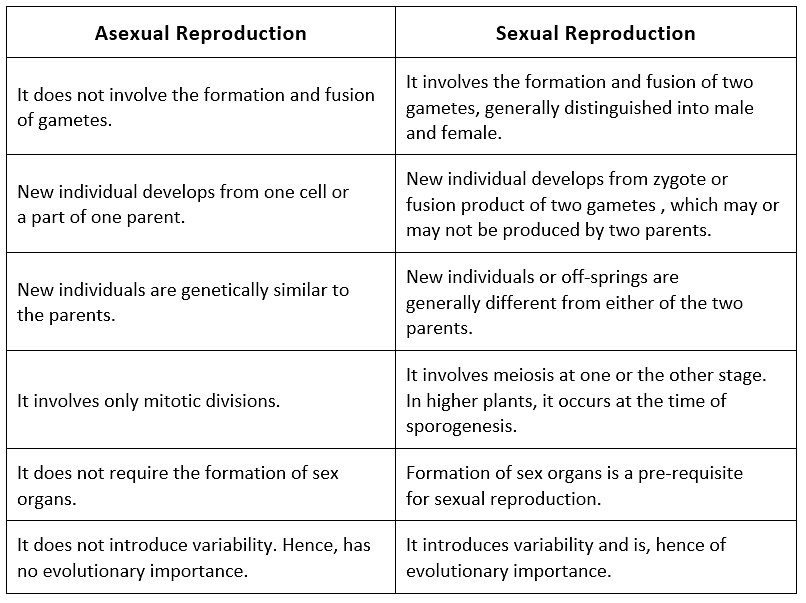
|
86 videos|294 docs|184 tests
|
FAQs on Asexual Reproduction in Plants - Biology Class 12 - NEET
| 1. What is asexual reproduction in plants? |  |
| 2. What are some common methods of asexual reproduction in plants? |  |
| 3. Why do plants use asexual reproduction? |  |
| 4. Are there any disadvantages of asexual reproduction in plants? |  |
| 5. Can a plant switch from asexual to sexual reproduction? |  |

|
Explore Courses for NEET exam
|

|
